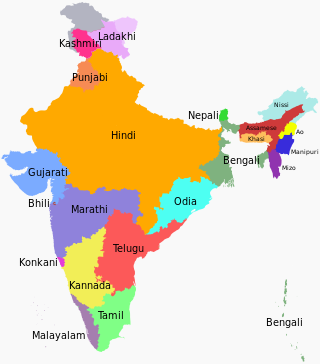
Modern Standard Hindi, commonly referred to as Hindi, is an Indo-Aryan language spoken chiefly in North India, and serves as the lingua franca of the Hindi Belt region encompassing parts of northern, central, eastern, and western India. Hindi has been described as a standardised and Sanskritised register of the Hindustani language, which itself is based primarily on the Khariboli dialect of Delhi and neighbouring areas of North India. Hindi, written in the Devanagari script, is one of the two official languages of the Government of India, along with English. It is an official language in nine states and three union territories and an additional official language in three other states. Hindi is also one of the 22 scheduled languages of the Republic of India.

Urdu is an Indo-Aryan language spoken chiefly in South Asia. It is the national language and lingua franca of Pakistan, where it is also an official language alongside English. In India, Urdu is an Eighth Schedule language the status and cultural heritage of which are recognised by the Constitution of India; and it also has an official status in several Indian states. In Nepal, Urdu is a registered regional dialect and in South Africa it is a protected language in the constitution. It is also spoken as a minority language in Afghanistan and Bangladesh, with no official status.

Puducherry, also known as Pondicherry, is a union territory of India, consisting of four small geographically unconnected districts. It was formed out of four territories of former French India, namely Pondichéry, Karikal (Karaikal), Mahé and Yanaon, excluding Chandannagar (Chandernagore), and it is named after the largest district, Puducherry, which was also the capital of French India. Historically known as Pondicherry, the territory changed its official name to Puducherry on 1 October 2006.
An official language is a language having certain rights to be used in defined situations. These rights can be created in written form or by historic usage.

Languages spoken in the Republic of India belong to several language families, the major ones being the Indo-Aryan languages spoken by 78.05% of Indians and the Dravidian languages spoken by 19.64% of Indians; both families together are sometimes known as Indic languages. Languages spoken by the remaining 2.31% of the population belong to the Austroasiatic, Sino–Tibetan, Tai–Kadai, and a few other minor language families and isolates. According to the People's Linguistic Survey of India, India has the second highest number of languages (780), after Papua New Guinea (840). Ethnologue lists a lower number of 456.
Bihari languages are a group of the Indo-Aryan languages. The Bihari languages are mainly spoken in the Indian states of Bihar, Jharkhand, Uttar Pradesh, and West Bengal, and also in Nepal. The most widely spoken languages of the Bihari group are Bhojpuri, Magahi and Maithili.

There is no national language in the Republic of India. However, article 343(1) of the Indian constitution specifically mentions that "The official language of the Union shall be Hindi in Devanagari script. The form of numerals to be used for the official purposes of the Union shall be the international form of Indian numerals," while article 343(2) allowed for the continuation of English as an official language for another 15 years and 343(3) gave the parliament the power to provide for the use of English language after this period. The clause 3 of the Official Languages Act, 1963 allows for the continued use of English language for official purposes of the Union government and for parliamentary business. Hence Indian English and Modern Standard Hindi are the Official Languages of the Government of India.

The Hindi Belt, also known as the Hindi Heartland, is a linguistic region encompassing parts of northern, central, eastern, and western India where various Northern, Central, Eastern and Western Indo-Aryan languages are spoken, which in a broader sense is termed as Hindi languages, with Standard Hindi serving as the lingua franca of the region.
A national language is a language that has some connection—de facto or de jure—with a nation. There is little consistency in the use of this term. One or more languages spoken as first languages in the territory of a country may be referred to informally or designated in legislation as national languages of the country. National languages are mentioned in over 150 world constitutions.

The Sahitya Akademi, India's National Academy of Letters, is an organisation dedicated to the promotion of literature in the languages of India. Founded on 12 March 1954, it is supported by, though independent of the Indian government. Its office is located in Rabindra Bhavan near Mandi House in Delhi.

Garhwali is an Indo-Aryan language of the Central Pahari subgroup. It is primarily spoken by over 2.5 million Garhwali people in the Garhwal region of the northern Indian state of Uttarakhand in the Indian Himalayas.
The anti-Hindi-imposition agitations in Tamil Nadu have been ongoing intermittently in the southern Indian state of Tamil Nadu since the early 20th century. The agitations involve several mass protests, riots, student and political movements in Tamil Nadu concerning the official status of Hindi in the state.
Hindi is one of the official languages in the Indian state of Bihar. Although Hindustani is the lingua-franca of the region, the majority of the people natively speak one of the Bihari languages.
Most of the languages of Bihar, the third most populous state of India, belong to the Bihari subgroup of the Indo-Aryan family. Chief among them are Bhojpuri, spoken in the west of the state, Maithili in the north, Magahi in center around capital Patna and in the south of the state. Maithili has official recognition under the Eighth Schedule to the Constitution of India. The official language of Bihar is Modern Standard Hindi, with Standard Urdu serving as a second official language in 15 districts.

Official Languages Commission is an Indian commission which was constituted by the president of India in pursuance to the provisions stated in the Article-344 of the Indian Constitution. This commission was constituted on June 7, 1955 vide a notification of the Ministry of Home Affairs, government of India.

The Ninety-second Amendment of the Constitution of India, officially known as The Constitution Act, 2003, amended the Eighth Schedule to the Constitution so as to include Bodo, Dogri, Maithili and Santali languages, thereby raising the total number of languages listed in the schedule to 22. The Eighth Schedule lists languages that the Government of India has the responsibility to develop.

Hindi Day is celebrated in India to commemorate the date 14 September 1949 on which a compromise was reached—during the drafting of the Constitution of India—on the languages that were to have official status in the Republic of India. The compromise, usually called the Munshi-Ayyangar formula, after drafting committee members K. M. Munshi and N. Gopalaswami Ayyangar, was voted by the Constituent Assembly of India after three years of debate between two opposing camps. The Hindi protagonists wanted Modern Standard Hindi register of the Hindustani language to be the sole "national language" of India ; the delegates from South India preferred English to have a place in the Constitution. The Munshi-Ayyangar formula declared (i) Hindi to be the "official language" of India's federal government; (ii) English to be an associate official language for 15 years during which Hindi's formal lexicon would be developed; and (iii) the international form of the Hindu-Arabic numerals to be the official numerals. The compromise resolution became articles 343–351 of India's constitution, which went into effect on 26 January 1950. In 1965, when the 15 years were up, the Government of India announced that English would continue to be the "de facto formal language of India."

The Eighth Schedule to the Constitution of India lists the official languages of the Republic of India. At the time when the Constitution was enacted, inclusion in this list meant that the language was entitled to representation on the Official Languages Commission, and that the language would be one of the bases that would be drawn upon to enrich Hindi and English, the official languages of the Union. The list has since, however, acquired further significance. The Government of India is now under an obligation to take measures for the development of these languages, such that "they grow rapidly in richness and become effective means of communicating modern knowledge." In addition, candidates sitting for an examination conducted for public service are entitled to use any of these languages as a medium to answer the paper.

The Department of Official Language is the Government of India's department responsible for the implementation of the provisions of the Constitution relating to official languages and the provisions of the Official Languages Act, 1963. Department of Official Language was set up in June 1975 as an independent Department of the Ministry of Home Affairs.













